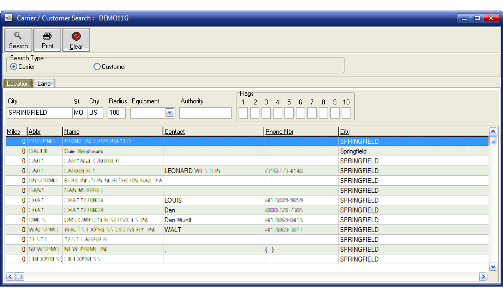More and more carriers are establishing brokerages to serve the needs of their customers and create another revenue stream, a low risk profit center related to their core business.

Jim Richards, President and CEO of KLLM
Industry pioneer KLLM Transport Services has been one of the country’s leading temperature-controlled carriers for more than 50 years and now runs 3,500 to 4,000 trucks throughout the United States and Mexico. KLLM also helped set a trend with the launch of its in-house brokerage in 2008. Carriers have been the fastest growing brokering segment ever since.
“Our brokerage operation is a strategic part of our growth plans but has different needs than the carrier side of the house,” said Jim Richards, president and CEO of KLLM.
Those differences called for a Transportation Management System (TMS) with different capabilities to support the brokerage. After implementing DAT Keypoint broker software on July 1, 2014, KLLM has overcome the limitations of its carrier TMS, increased efficiency, attracted top-caliber talent, and boosted revenues and profitability.
Overcoming Carrier TMS Limitations
Learn more about DAT Keypoint
For years the asset side of KLLM’s business has used an IBM AS/400 server-based TMS. Before DAT Keypoint went live at KLLM, the brokerage used an add-on program written for the AS/400 system. That created numerous stumbling blocks that prompted a search for a best-of-breed system.
“We chose DAT Keypoint because it was designed specifically for brokerages, particularly its single-entry operations and capacity tools,” said Richards. “DAT Keypoint’s broker analytics and reporting functions were also critical to our decision.”
For KLLM Director of Logistics Cassie Icamina, DAT Keypoint had all the bells and whistles the company wanted in one package in the right price range. The integrations, including the DAT Load Board, were a plus, as was Keypoint’s responsive support team.
“With Keypoint, we get freight out to our carrier base much faster,” said Icamina. “We can send rate confirmations and post loads automatically. Thanks to the integration with DAT CarrierWatch®, we can also qualify carriers more quickly. By moving more freight, we increase revenues and profitability.”
Currently 25 users in KLLM’s Logistics division use DAT Keypoint, including 16 brokers, 3 sales people and several others in accounting and management. The users are spread out across five satellite offices and their headquarters located in Jackson, MS.

DAT Keypoint allows you to make tailored load lists for your carriers.
Increasing Efficiency
Icamina says Keypoint has met and exceeded KLLM’s short-term goals. “Keypoint has helped us become much more efficient,” she said. “If I compare the amount of work we accomplished before Keypoint with what the same number of people can do now, I know we’ve increased productivity.”
As the logistics division grows, KLLM plans to expand the Keypoint capabilities they use. Icamina is considering additional modules, including the Web portal and the Customer Relationship Management module.
DAT Keypoint also integrates well with the AS/400 system on KLLM’s asset side. Using Electronic Data Interchange, DAT Keypoint and the carrier TMS can easily transmit and receive information electronically.
Attracting Top-Caliber People
Icamina has hired five new brokers/sales people in the past two months, evidence of KLLM’s fast-growth model. But for the first time ever, she knows the technology she is offering matches the caliber of people she’s bringing on. Before DAT Keypoint, she found hiring top-notch talent somewhat daunting.
“Keypoint opened up doors,” Icamina said. “Now that we have software that’s more developed, we can hire the best talent.”
That’s important to Icamina, because KLLM has no plans to slow down.


